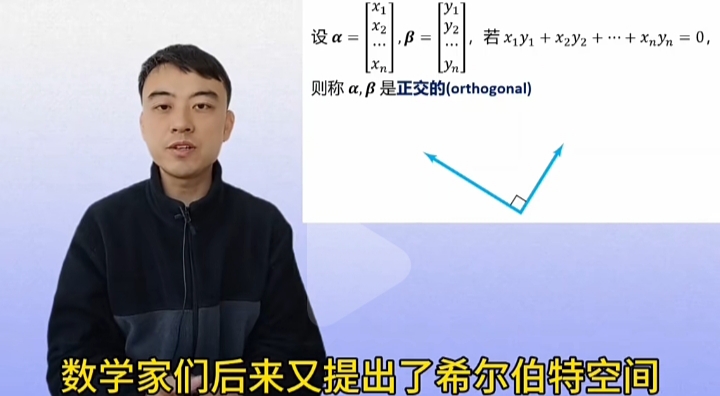SciTech-Mathmatics - Advanced Linear Algebra(高等线性代数): 总结: Space的 变换 与 运算 + 正交向量 与 正交矩阵 + 同空间任两个Vectors可通过Matrix变换互相转化 + 方阵(满秩)不改变向量维数
SciTech-Mathmatics - Advanced Linear Algebra(高等线性代数):
总结: Space的 变换 与 运算 + 同空间任两个Vectors可通过Matrix变换互相转化 + 方阵(满秩)不改变向量维数
Equations(方程组) + 行列式
Vector(向量) + Vector Space(向量空间) + Matrix(矩阵)
Vector:
- 线性 无关 和 极大线性无关组
- 线性相关、线性空间 、基(空间)
- 正交向量
Vector Space
Vectors 的线性组合
Matrix
- 矩阵的秩
- 矩阵的 特殊类型:
- 单位矩阵
- 对角矩阵
- 上/下三角
- 对称矩阵
- 矩阵 的 运算
- 矩阵 的 "加" 与 "乘"
- 矩阵 变换
- 矩阵的“特征值分解”
- 公式
- 特征多项式
正交向量 与 正交矩阵
\(\large Orthogonal \ Vectors\)(正交向量) 和 \(\large Orthogonal \ Matrix\)(正交矩阵)
\(\large Orthogonal \ Vectors\)(正交向量)
-
Definition:
\(\large \text{Linear Space } \bf{K^n}\)上, 任何两个 \(\large \text{ Vectors }\)
\(\large \begin{array}{ll} \bf{ V_{a_{n \times 1}} = \begin{bmatrix} v_{a_1} \\ \vdots \\ v_{a_n} \end{bmatrix} \bf{ \neq 0 }, v_{a_i}} \in K, i \in [1,n] \\ \bf{ V_{b_{n \times 1}} = \begin{bmatrix} v_{b_1} \\ \vdots \\ v_{b_n} \end{bmatrix} \bf{ \neq 0 }, v_{b_i}} \in K, i \in [1,n] \end{array}\)如果 $\large \bf{ V_{a_{n \times 1}} } \cdot \bf{ V_{b_{n \times 1}} } = \overset{n}{\underset{i =1}{\sum}}{ ( v_{a_i} \times v_{b_i} ) } = 0 $
则称 \(\large \bf{ V_{a_{n \times 1}} } 与 \bf{ V_{b_{n \times 1}} } 是一对 \ Orthogonal \ Vectors\) -
Properties:
\(\large \bf{ K^{n} } \text{ 的 } Orthogonal(正交) \text{ 是 } \bf{ R^{2} } \text{ 的 } 垂直 \text{ 向 } 高维空间 \text{ 的推广 }\)

\(\large Orthogonal \ Matrix\)(正交矩阵)
\(\large \text{实数域 } \bf{ R } 上的 \bf{方阵} A\) 如果满足:
则称$\large \bf{方阵} A \text{ 是 } \bf{Orthogonal \ Matrix(正交矩阵)} $,注意:
Example: 判断方阵 A 是否正交矩阵: \(\large A = \begin{bmatrix} cos\ \theta & - sin\ \theta \\ sin\ \theta & cos \ \theta \end{bmatrix}, \ \theta \in R\)
- 解法一: 按 正交矩阵 的定义判断
\(\large \begin{array}{ll} \because & \bf{ I } = A^{T} A = \begin{bmatrix} cos\ \theta & sin\ \theta \\ -sin\ \theta & cos \ \theta \end{bmatrix} \begin{bmatrix} cos\ \theta & - sin\ \theta \\ sin\ \theta & cos \ \theta \end{bmatrix} \\ & = \begin{bmatrix} (cos\ \theta cos\ \theta + sin\ \theta sin\ \theta ) & (- cos\ \theta sin\ \theta + sin\ \theta cos\ \theta ) \\ (-sin\ \theta cos\ \theta + cos\ \theta sin\ \theta ) & (sin\ \theta sin\ \theta + cos\ \theta cos\ \theta ) \end{bmatrix} \\ & = \begin{bmatrix} 1 & 0 \\ 0 & 1 \end{bmatrix} = \bf{ I } \\ \therefore & A \text{ is } Orthogonal \ Matrix(正交矩阵) \end{array}\) - 解法二: 按\(\large \bf{R^{2}}\)的"Matrix Transformation(矩阵变换)"判断
\(\large \begin{array}{ll} \because & A^{T} = \begin{bmatrix} cos\ \theta & sin\ \theta \\ -sin\ \theta & cos \ \theta \end{bmatrix} = \begin{bmatrix} cos\ (-\theta) & - sin\ (-\theta) \\ sin\ (-\theta) & cos \ (-\theta) \end{bmatrix} \\ & A^{T} 是 \bf{R^{2}} 上角度为 \bf{ -\theta } 的 \text{旋转变换矩阵}。\\ & A = \begin{bmatrix} cos\ \theta & - sin\ \theta \\ sin\ \theta & cos \ \theta \end{bmatrix} \\ & A 是 \bf{R^{2}} 上角度为 \bf{ \theta } 的 \text{旋转变换矩阵}。\\ & 那么 \bf{ (A^{T}A ) }是角度为\bf{ 0=(\theta -\theta) }的旋转变换矩阵 \\ & 即: A^{T}A = \begin{bmatrix} cos\ 0 & - sin\ 0 \\ sin\ 0 & cos \ 0 \end{bmatrix} = \begin{bmatrix} 1 & 0 \\ 0 & 1 \end{bmatrix} = \bf{ I } \\ \therefore & A \text{ is } Orthogonal \ Matrix(正交矩阵) \end{array}\)



 浙公网安备 33010602011771号
浙公网安备 33010602011771号